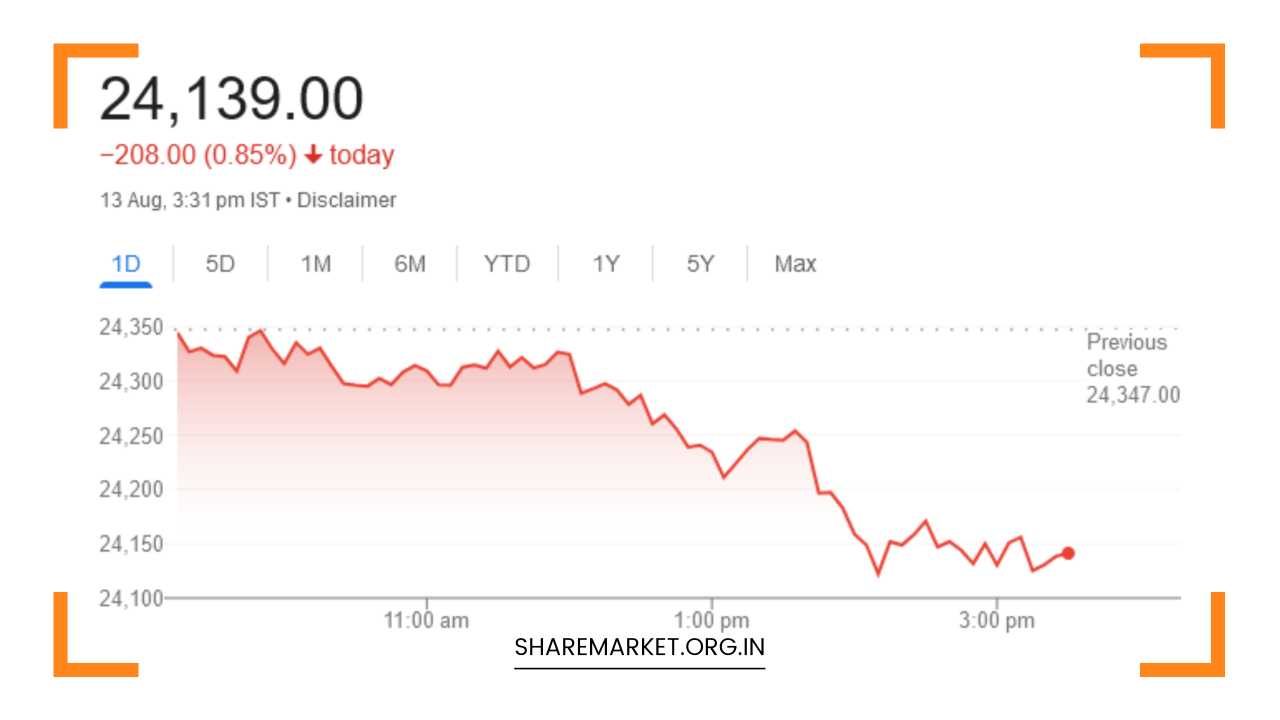Nifty Close in Red Amid Mixed Global; Nifty Prediction for Tomorrow

Nifty Prediction for Tomorrow
Share Market Update: Domestic Indices Close in Red Amid Mixed Global Signals
The Indian stock market experienced a decline on August 13, with benchmark indices closing lower as a result of mixed global cues and ongoing selling pressure from foreign institutional investors (FIIs).
This market downturn has been further exacerbated by recent data indicating a slowdown in the manufacturing sector, as reflected in the latest Index of Industrial Production (IIP) figures. Investors are increasingly wary as high valuations contribute to the downward momentum.
Market Performance Overview
On August 13, the Indian benchmark indices ended the trading session in negative territory. The Nifty fell below the 24,150 mark, closing at 24,139, down by 208 points or 0.85%.
The Sensex, another key benchmark, closed at 78,956.03, down by 692.89 points, which equates to a decline of 0.87%. Overall, the market exhibited a broad-based sell-off, with 1,103 stocks advancing, 2,322 stocks declining, and 74 stocks remaining unchanged.
In terms of individual stock performance, Titan Company, Apollo Hospitals, Dr. Reddy’s Laboratories, Tata Consumer Products, and HCL Technologies were among the top gainers in the Nifty index.
Conversely, Shriram Finance, Bharat Petroleum Corporation Limited (BPCL), HDFC Life, HDFC Bank, and Bajaj Finance experienced the most significant losses.
The overall sentiment in the market was dampened as all sectoral indices ended in the red, with declines observed in Banks, Power, Oil & Gas, Metals, and Media & Telecom, all registering around a 1% decrease.
The BSE Midcap and Smallcap indices also experienced similar declines, each falling by approximately 1%.
Expert Insights
Aditya Gaggar, a market analyst at Progressive Shares, noted that the trading session began sluggishly, but bearish sentiments quickly took over.
The Nifty index remained in negative territory throughout the day, with significant pressure observed in the Metal and PSU Bank sectors.
A mixed trend was noted in the broader market; while the midcap index marginally outperformed, the smallcap index fell by over 1%.
Gaggar advised traders to wait for a decisive breakout, as the index returned to the range of 23,960-24,400. He emphasized that until the index breaks through either end of this range, a clear trading direction remains elusive.
Vinod Nair from Geojit Financial Services echoed similar sentiments, stating that the domestic market’s decline was primarily driven by a combination of mixed global cues and domestic economic indicators.
The latest IIP data suggests a slowdown in the manufacturing sector, raising concerns among investors. Nair highlighted that the continued selling pressure from FIIs, alongside high market valuations, is contributing to the prevailing bearish trend.
Despite the market’s resilience to recent negative developments, such as geopolitical tensions and inflationary pressures, the overall outlook appears cautious.
He warned that if the negative trends in corporate earnings persist in upcoming quarters, investors might need to reassess their positions.
Ajit Mishra of Religare Broking also commented on the current market situation, noting that the Nifty is under pressure after failing to break through the 20-day Exponential Moving Average (EMA) resistance level.
He indicated that the index might retest the 24,000 support zone, as the decline in banking stocks has hindered any recovery attempts.
Mishra advised investors to closely monitor leveraged positions and wait for clearer signals from the market before making significant trading decisions.
IIP Data and Manufacturing Sector Slowdown
The recent IIP data revealed signs of a slowdown in the manufacturing sector, which has raised concerns among investors and analysts alike.
The manufacturing sector is a critical component of the Indian economy, contributing significantly to overall GDP growth. A slowdown in this sector can have far-reaching implications for employment, investment, and economic stability.
The IIP figures, which indicate the production levels in various industries, have shown a decline, leading analysts to speculate about potential economic headwinds.
If the trend continues, it could prompt the Reserve Bank of India (RBI) to reassess its monetary policy stance, particularly if inflationary pressures begin to ease.
Investors are particularly focused on the manufacturing sector’s performance, as it is often seen as a bellwether for overall economic health.
Global Market Influences
The global market landscape has also contributed to the cautious sentiment in the domestic market. With mixed signals emanating from international markets, including fluctuations in major indices and geopolitical tensions, investors are adopting a more conservative approach.
Uncertainties regarding interest rate hikes, inflation, and global economic recovery are weighing heavily on market sentiment.
For instance, global indices have shown volatility due to changing economic indicators in major economies. This mixed global backdrop has made Indian investors particularly cautious, as any significant movements in foreign markets can have a ripple effect on domestic trading.
Sector-Specific Trends
Examining sector-specific trends, the banking sector has come under pressure due to rising non-performing assets (NPAs) and concerns over asset quality.
The recent results from several banks have not met investor expectations, leading to a sell-off in bank stocks. Additionally, the high valuations in the banking sector are causing some investors to reevaluate their holdings.
On the other hand, sectors such as IT have shown resilience amidst the broader market decline. As companies increasingly turn to digital solutions and technological advancements, the IT sector remains a critical area of focus for investors.
The performance of tech stocks can often be a leading indicator of market sentiment, especially in a globally interconnected economy.
Final Remarks
As the Indian stock market navigates through these turbulent waters, investors are advised to remain vigilant and patient.
The mixed global cues, coupled with domestic economic challenges, are creating a complex landscape for traders and investors alike. The ongoing selling pressure from FIIs and the recent slowdown in the manufacturing sector add to the uncertainty.
Market participants should closely monitor the developments in the IIP data, global market trends, and sector-specific performances.
Furthermore, waiting for clearer signals and potential breakouts in key indices could provide better opportunities for investment.
With the current market dynamics, maintaining a diversified portfolio and adopting a cautious approach could be prudent strategies for navigating the evolving market conditions.

















